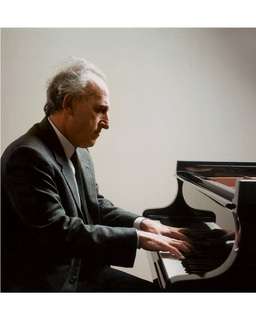|
Back
Fire And Ice New York
Isaac Stern Auditorium, Carnegie Hall
04/18/2010 -
Frédéric Chopin: Two Nocturnes, Op. 27 – Preludes, Op. 28 – Ballade No. 1, Op. 23 – Scherzo No. 1, Op. 20 – Etude in A-flat Major, Op. 25, No. 1, "Aeolian Harp" – Etude in F Minor, Op. 25, No. 2 – Etude in F Major, Op. 25, No. 3, "Cartwheel" – Etude in A Minor, Op. 25, No. 4 – Etude in C-sharp Minor, Op. 25, No. 7, "Cello" – Etude in B Minor, Op. 25, No. 10 – Etude in A Minor, Op. 25, No. 11, "Winter Wind" – Etude in C Minor, Op. 25, No. 12, "Ocean"
Maurizio Pollini (Pianist) 
M. Pollini (© Gabriela Brandenstein/DG)
A Maurizio Pollini recital is always An Event–with capital letters. This afternoon’s Event was one of three he will offer in the next two weeks, each guaranteed a sellout with seats placed on the stage. For nobody can resist such a diabolical keyboard artist.
Even more intriguing, this is Chopin’s 200th birthday–and exactly 50 years since Maurizio Pollini won the International Chopin Competition in Warsaw at the age of 18, ensuring his career.
Still, a Pollini Event is never as eventful as it should be. He is not idiosyncratic in the usual sense of the word, but his playing can be either moody or electric. He can play Boulez with the verve of a Liszt. Or he can play Schubert with the icy veneer of a Webern.
But Mr. Pollini never leaves anyone completely cold, for he has the most ear-popping finger work in the history of the piano. At his best, Mr. Pollini can shatter any concert hall with his artistry. When not so good–as he was this afternoon–one imagines him as a theoretical physicist aggressively filling a blackboard with complex equations. One hardly jumps with joy at the beauty of the mathematics, but mathematics has its own cerebral thrill.
Pollini’s Chopin may not be warm, he may think that rubato is a dirty word. But at his bravura best, nothing can be more exciting. This was certainly true for much of the Opus 25 Etudes. Not so much Numbers 2 and 7, where introspection is the key. But when Mr. Pollini came to the whirling “Winter Wind” or the F Major Etude, which revels in pin-point precision, Mr. Pollini couldn’t be stopped. The last one in C Minor was played brilliantly, majestically, yet one wishes he had paused for a fractional fraction, to let that marvelous bass line extend through the architecture. That was not to be, so we had to simply wonder at his technical legerdemain.
Were they played so brilliantly that nobody else could come near him? Yes, but along with the electricity should come shadows, nuances, and Mr. Pollini tried to avoid them.
The Nocturnes were another story. Mr. Pollini played them as though taking a single breath for each. When the directions call for Allegro appassionato (Number 24), one could not even hear the fingers going. Nothing was blurred, not a single note was missed, but Mr. Pollini was in a hurry to finish. Little difference was felt between the F Minor and the E flat prelude, where architecture was subservient to fingers. After these amazing displays, the “Funeral” prelude was like an interruption for the great chases of left hand and right hand.
With other virtuosi, sometimes one has the guilty wish to see them crash, like race-car drivers. Not so the mesmerizing Mr. Pollini. Not only is he faultless, but he revels in never failing on a digital race. To some it may be cold. To others, like this listener, every work was a cadenza.
This wasn’t inevitably true. The opening nocturnes introduced us to the mysterious Chopin of chromatics and dissonances. Again one felt he was playing the notes with a fraction more volition than they should be. Nobody has ever figured out Chopin’s strange dissonances in the second nocturne, but we like to unravel the mystery. Mr. Pollini never allowed us such ruminations, fatuous as they may be.
The First G Minor Ballade started with that cello-like line as if Mr. Pollini was ready to let the music carry him. Indeed, he never had to force this work. It was never as poetic as, say, an Ashkenazy would play it, but certainly this was a well-wrought work.
I was originally going to say that the Scherzo moved with an almost ugly spirit. And then, taking a break here, I read that Chopin said “this work is a charnel house” – i.e., a place where bones and skulls of the dead are deposited. If that was Chopin’s idea, well, Pollini was his man!
He did play three encores, even while a few ingrates were leaving. And while he tore into the “Revolutionary” Etude with quite appropriate violence, he allowed ruminative time for both the third Opus 3 Mazurka and the Third Scherzo.
It was as if Mr. Pollini had said to himself, “Well, I sure amazed this Carnegie Hall audience. They loved my muscles, my brilliant phrasing, my unbelievable fingers. And now that the lesser mortals have gone home, I’m going to actually enjoy myself!”
Harry Rolnick
|